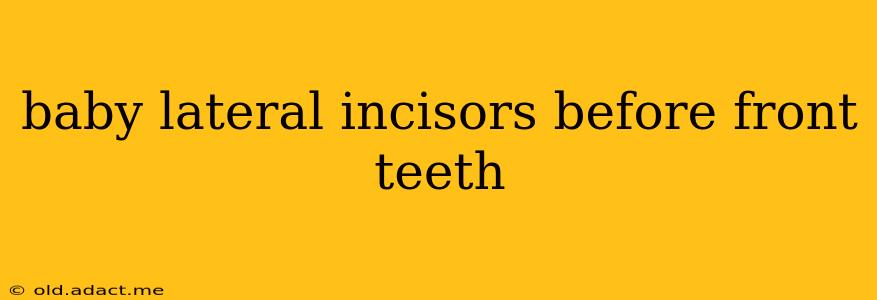The eruption of baby teeth, also known as deciduous teeth, follows a general pattern, but variations are completely normal. While most children see their central incisors (the two front teeth) erupt first, it's not uncommon for the lateral incisors (the teeth next to the central incisors) to appear before them. This isn't necessarily a cause for concern, but understanding the reasons and implications can alleviate parental anxiety.
Why Do Baby Lateral Incisors Sometimes Erupt Before Central Incisors?
There isn't one single definitive answer to why this variation occurs. Several factors can influence the order of tooth eruption:
-
Genetic Predisposition: Just like many other aspects of development, genetics play a significant role. A family history of unusual tooth eruption patterns can increase the likelihood of a child experiencing the same.
-
Individual Variation: Every child develops at their own pace. Minor variations in timing are perfectly normal and don't necessarily indicate a problem. Think of it like variations in height or weight among children of the same age – it's simply the range of typical development.
-
Hormonal Influences: Hormonal fluctuations during pregnancy and infancy can subtly impact tooth development.
-
Nutritional Factors: While not a direct cause, adequate nutrition is essential for overall growth and development, including teeth. Nutritional deficiencies can potentially affect the timing and sequence of tooth eruption, though this is less common than genetic and individual variations.
Is it a Cause for Concern if My Child's Lateral Incisors Came in First?
In most cases, no. The difference in eruption timing is usually minor and doesn't affect the long-term health or alignment of the teeth. However, observing the overall pattern of tooth eruption is important. If there are significant delays or other irregularities in the eruption pattern, consulting a pediatric dentist is recommended.
What Should I Do If I Notice This Variation?
-
Monitor the Eruption Pattern: Keep track of when each tooth erupts. This information can be valuable for your dentist.
-
Maintain Good Oral Hygiene: Brush your child's teeth gently twice a day with a fluoride toothpaste (pea-sized amount) to prevent cavities.
-
Schedule Regular Dental Checkups: Regular checkups (starting around age one) allow your dentist to monitor your child's dental development and address any potential concerns early on.
-
Consult Your Pediatric Dentist: If you have any concerns about the timing or pattern of your child's tooth eruption, or if there are other developmental irregularities, consult a pediatric dentist for a professional assessment.
How Long Does it Take for Baby Teeth to Erupt?
The eruption of baby teeth typically begins around 6 months of age, with the process generally completing by around 30 months. However, the timing can vary considerably between children.
What Happens if My Child's Baby Teeth Don't Erupt at All?
The absence of baby teeth, also known as anodontia, is relatively rare. If your child's baby teeth are not erupting according to the expected timeframe or are missing entirely, it is crucial to consult a pediatric dentist or orthodontist. This could indicate an underlying medical condition requiring further investigation and management.
Are there any long-term implications if the lateral incisors erupt first?
Generally, no. The order of baby teeth eruption rarely impacts the long-term alignment or health of adult teeth. However, regular dental checkups are still essential to monitor development and address any potential issues that might arise later.
Remember, the information provided here is for general knowledge and should not be considered medical advice. Always consult a qualified pediatric dentist for any concerns regarding your child's dental health.
